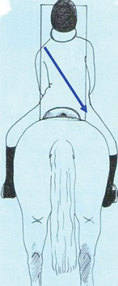One sidedness in horse and rider
Posted on
One sidedness in horses can be due to the one sidedness of the rider, if you have read my training guide on rider crookedness, you should be aware of how your own crookedness can affect the horse in many ways.
This article is drawn more towards the one side dominant rider, the one who isn’t aware that the left leg is loose and hanging, while the right leg is tight and holding, or the rider who doesn’t seem to hold the reins equally etc
Throughout training the horse, we are always striving to equal the horse out, encourage flexibility and suppleness equally to both reins, but how can the horse achieve this if we are blocking him or giving him contradicting signals through our own lack of ambidexterity?
“But I am not ambidextrous, I am right (or left) handed” I hear you say, how can I be ambidextrous? Is it even possible to become ambidextrous?
The answer is yes you can, it takes some work, but do we not realise that the work we put into our horses takes work too? If we are willing to train the horse and work at it, why should we not work on ourselves and be as equal as possible?
Very few people are born naturally ambidextrous, but it happens, my own son James is predominantly left handed, however when he was young, he would be drawing or writing and I would often catch him using his right hand, “why are you using that hand?” I would ask, “because my left hand is tired” he would say. So from a young age, he was actually writing, drawing and colouring in with both hands. Nowadays at 12yrs old, he does use his left hand more, but is still capable of writing, with the same neatness, with his right hand.
This can always be useful should he ever, heaven forbid, have an accident and his left (dominant) hand is injured, he has use of the right one as back up!
How does this impact on your riding? Well, take the right handed rider who has the horse beautifully balanced to the right rein, yet the left rein in weak and the horse falls in or out, swings his quarters in etc. On the right rein the rider is communicating through the seat bones and hip which help control the horse, as she changes the rein, the left seat bone may be lighter so not connected, the hip is perhaps not allowing the thigh to hang and therefore the riders leg is not as effective as perhaps it needs to be, also the riders weight will be heading towards the right side of the horse. The overall effect is the horse has difficulty staying underneath the rider so has trouble maintaining his own balance.
It is sometimes a case that you may have been injured in the past, therefore when riding, your mind subconsciously protects the previously injured area, which can also affect your one sidedness, equally, the way the horse moves can affect you too.
So how do you become more equal and ambidextrous?
First you have to analyse where your problem stems from, is it a weak posture, is it protection of an old injury, is it the way the horse moves?
As we are looking at ambidexterity, we are going to look at ways in which you can help yourself, and not necessarily how you would expect!
Some things which can add to your ambidexterity is to begin using your “weak or wrong hand” for things instead of always relying on your “strong hand”.
Ask your trainer to or friend to video you riding your usual horse and in your usual way, review the video, then note down the effects of your dominant side compared to your less dominant side, do you notice any difference? This is your starting point.
Now you are ready to address your ambidexterity.
Try some of the following exercises when not on the horse:
- Carry your shopping or buckets in the “wrong” hand
- Carry your shoulder bag on the “wrong” shoulder
- When mucking out, use the “wrong” hand
- Practise writing your name with the “wrong” hand
- Brush your teeth and hair with the “wrong” hand
- Tack up/ rug up from the “wrong” side
Try these exercises on the horse:
- Work without stirrups is great for balance but equally helps us recognise our weaknesses, especially on circles, as the gravity “pulls” you to the outside of the circle, on your weaker side you may find it much harder to stay central
- Lunge lessons
- Carry the whip in your weak hand for longer, ensuring it is correctly positioned
- Mount from the “wrong side”
- Dismount from the “wrong side”
- Make a conscious effort to “work” the weaker side more when following the horses movement
All these ideas seem strange when first attempted, but as with everything, practise makes perfect, so give them a go, after a while the unnatural feel will become just as normal as your “stronger” hand/side.
These exercises are just a suggestion for things you can do, but whenever you can, use your “wrong” hand/side for everyday tasks, you may be surprised at the results in your riding.
After a few weeks of practising using your “wrong” hand/side, ask to be filmed again, then compare your “before” and “after” rides. By this point you should see a notable difference, however just as training your horse never ends, your own ambidexterity should continue to be worked on.

